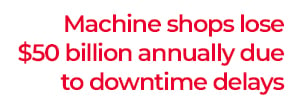Fire suppression systems installed on CNC machines protect machines, employees, and the surrounding manufacturing area. As a member of the machining community, we understand that if you’re not up and running, you’re losing money. To make sure you’re running the most profitable business, you can assess your current risk of fire and learn how to implement proper protection measures to maximize success.
Which CNC Machines Have a Fire Risk?
The key criteria to assess whether your CNC machine is at risk of a fire is the use of oil-based coolant and if you are running lights out machining applications.
Oil-Based Coolants
Whether you’re using Swiss Screw machines, grinders, or just working in precision parts, using oil-based coolants is a commonplace practice in machine shops around the globe. These coolants can pose a fire risk due to the working conditions they are exposed to in CNC applications. The high-speed nature of the machining process creates enormous amounts of friction, which releases heat energy. This environment, combined with highly flammable oil-based coolants, creates optimal conditions for a single spark to send the whole machine up in flames. When machining with oil-based coolants, it is crucial for your shop to assess what kinds of fire safety measures should be taken to protect against fires and the implications it could have for the business.
Lights Out Machining
Lights out machining can be a great option for many machine shops. It allows you to add extra machining time to meet lucrative contract requirements and increases the efficiency and profitability of your shop. However, running machines without operators does come with added risks. The risk of fire during lights out shifts not only increases in machinery running with oil-based coolant but also with synthetic or semisynthetic coolants. When running unattended with synthetic or semisynthetic coolants, the water could evaporate, reducing the flash point and increasing the fire risk. Without any workers monitoring machines, damage from a fire could be detrimental if there is no fire protection put in place. By assessing your shop’s situation and implementing proper risk mitigation tools, you can help to ensure maximum uptime, efficiency, and profitability for your business.
Common causes of CNC Machine Fires
When it comes to different factors causing CNC machine fires, you must start with understanding the fire triangle. The three sides of the fire triangle are oxygen, fuel source, and heat. A CNC machine that is running oil already has two of the three sides in place – oxygen and fuel. The process of machining alone generates a lot of heat, and one of the factors below can create the spark to ignite the fire.
- tools breaking
- tools and/or materials getting too hot from friction
- a tool being improperly used or not placed correctly
These are common occurrences in machine shops. It only takes one time for these events to occur, completing the fire triangle and being detrimental to your business.
Why Should You Retrofit with a Fire Suppression System?
After gaining an understanding of your fire risk, you might be asking if retrofitting is of value to my business? Let’s look at how the cost of a fire adds up, should you have one.
Cost of machine: $150,000-$500,000
Downtime: Some machine shops have reported they complete up to $16,000 worth of machining per shift per machine. If a fire damages a machine, it could take up to three weeks for repairs or replacement. If you’re running lights out, 24/7 operations, this could mean over $1,000,000 of revenue lost. In more serious cases, when a machine is a total loss it can take up to a year to receive a replacement machine, resulting in loss of contracts.
worth of machining per shift per machine. If a fire damages a machine, it could take up to three weeks for repairs or replacement. If you’re running lights out, 24/7 operations, this could mean over $1,000,000 of revenue lost. In more serious cases, when a machine is a total loss it can take up to a year to receive a replacement machine, resulting in loss of contracts.
Industry studies have shown that over 40 percent of businesses closed by a significant disaster never reopen and nearly 30 percent fail within three years after reopening.
Even a small fire can cause thousands of dollars in lost revenue, insurance claims, and injuries. Better to be safe than sorry, as the old saying goes! Retrofitting fire suppression systems on your machines can save you time, money, and even your entire business.


